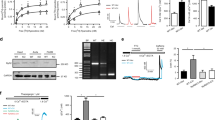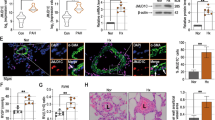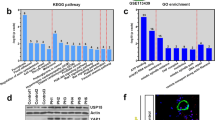Abstract
Chronic hypoxia (CH) causes remodeling not only in pulmonary arteries but also in pulmonary veins. Pulmonary vascular remodeling stems from increased pulmonary vascular myocyte proliferation. However, the pathogenesis of CH-induced proliferation of pulmonary venous smooth muscle cells (PVSMCs) remains unknown. The present study aimed to explore the mechanisms by which CH affects PVSMCs proliferation. PVSMCs were isolated from rat distal pulmonary veins and exposed to CH (4% O2 for 60 h). The expression of calcium sensing receptor (CaSR) was determined by immunofluorescence, real-time quantitative PCR and Western blotting. Cell proliferation was assessed by cell counting, CCK-8 assay, and BrdU incorporation. Apoptosis analysis was examined by flow cytometry. In rat distal PVSMCs, CH increased the cell number and cell viability and enhanced DNA synthesis, which is accompanied by upregulated mRNA and protein expression levels of CaSR. Two negative CaSR modulators (NPS2143, NPS2390) not only attenuated CH-induced CaSR upregulation but also inhibited CH-induced increases in cell number, cell viability and the proliferation index of PVSMCs, whereas two positive modulators (spermine, R568) not only amplified CH-induced CaSR upregulation but also intensified CH-induced increases in cell number, cell viability and the proliferation index of PVSMCs. Silencing CaSR with siRNA similarly attenuated the CH-induced enhancement of cell number, cell viability and DNA synthesis in PVSMCs. Neither CH nor downregulation of CaSR with siRNA had an effect on apoptosis in PVSMCs. These results suggest that CaSR mediating excessive proliferation is a new pathogenic mechanism involved in the initiation and progression of distal PVSMCs proliferation under CH conditions.
This is a preview of subscription content, access via your institution
Access options
Subscribe to this journal
Receive 12 print issues and online access
$259.00 per year
only $21.58 per issue
Buy this article
- Purchase on Springer Link
- Instant access to full article PDF
Prices may be subject to local taxes which are calculated during checkout







Similar content being viewed by others
References
Humbert M, Morrell NW, Archer SL, Stenmark KR, MacLean MR, Lang IM et al. Cellular and molecular pathobiology of pulmonary arterial hypertension. J Am Coll Cardiol. 2004;43:13s–24s.
Jiang X, Li T, Sun J, Liu J, Wu H. Setd3 negatively regulates vegf expression during hypoxic pulmonary hypertension in rats. Hypertension Res. 2018;41:691–8.
Fayyaz AU, Edwards WD, Maleszewski JJ, Konik EA, DuBrock HM, Borlaug BA et al. Global pulmonary vascular remodeling in pulmonary hypertension associated with heart failure and preserved or reduced ejection fraction. Circulation 2018;137:1796–810.
Humbert M, Guignabert C, Bonnet S, Dorfmuller P, Klinger JR, Nicolls MR et al. Pathology and pathobiology of pulmonary hypertension: State of the art and research perspectives. Eur Respir J. 2019;53:1801887. https://doi.org/10.1183/13993003.01887-2018.
Chazova I, Robbins I, Loyd J, Newman J, Tapson V, Zhdaov V et al. Venous and arterial changes in pulmonary veno-occlusive disease, mitral stenosis and fibrosing mediastinitis. Eur Respir J. 2000;15:116–22.
Andersen KH, Andersen CB, Gustafsson F, Carlsen J. Pulmonary venous remodeling in copd-pulmonary hypertension and idiopathic pulmonary arterial hypertension. Pulm Circ. 2017;7:514–21.
Leopold JA. Pulmonary venous remodeling in pulmonary hypertension: the veins take center stage. Circulation 2018;137:1811–3.
Takahashi H, Soma S, Muramatsu M, Oka M, Fukuchi Y. Upregulation of ET-1 and its receptors and remodeling in small pulmonary veins under hypoxic conditions. Am J Physiol Lung Cell Mol Physiol. 2001;280:L1104–14.
Salinas CE, Blanco CE, Villena M, Giussani DA. High-altitude hypoxia and echocardiographic indices of pulmonary hypertension in male and female chickens at adulthood. Circulation J. 2014;78:1459–64.
Nergui S, Fukumoto Y, Do EZ, Nakajima S, Shimizu T, Ikeda S et al. Role of endothelial nitric oxide synthase and collagen metabolism in right ventricular remodeling due to pulmonary hypertension. Circulation J 2014;78:1465–74.
Elias-Al-Mamun M, Satoh K, Tanaka S, Shimizu T, Nergui S, Miyata S et al. Combination therapy with fasudil and sildenafil ameliorates monocrotaline-induced pulmonary hypertension and survival in rats. Circulation J 2014;78:967–76.
Jiang Y, Zhou Y, Peng G, Liu N, Tian H, Pan D et al. Topotecan prevents hypoxia-induced pulmonary arterial hypertension and inhibits hypoxia-inducible factor-1α and TRPC channels. Int J Biochem Cell Biol. 2018;104:161–70.
Johar D, Magdeldin S. Application of laser scanning cytometry in vascular smooth muscle remodeling. Hypertension Res. 2018;41:869–85.
He RL, Wu ZJ, Liu XR, Gui LX, Wang RX, Lin MJ. Calcineurin/ NFAT signaling modulates pulmonary artery smooth muscle cell proliferation, migration and apoptosis in monocrotaline-induced pulmonary arterial hypertension rats. Cell Physiol Biochem. 2018;49:172–89.
Song S, Carr SG, McDermott KM, Rodriguez M, Babicheva A, Balistrieri A et al. STIM2 (Stromal interaction molecule 2)-mediated increase in resting cytosolic free Ca(2+) concentration stimulates pasmc proliferation in pulmonary arterial hypertension. Hypertension 2018;71:518–29.
Chen M, Shen C, Zhang Y, Shu H. MicroRNA-150 attenuates hypoxia-induced excessive proliferation and migration of pulmonary arterial smooth muscle cells through reducing HIF-1α expression. Biomed Pharmacother. 2017;93:861–8.
Jiang R, Shi Y, Zeng C, Yu W, Zhang A, Du Y. Protein kinase Cα stimulates hypoxia‑induced pulmonary artery smooth muscle cell proliferation in rats through activating the extracellular signal‑regulated kinase 1/2 pathway. Mol Med Rep. 2017;16:6814–20.
Li YX, Run L, Shi T, Zhang YJ. CTRP9 regulates hypoxia-mediated human pulmonary artery smooth muscle cell proliferation, apoptosis and migration via TGF-β1/ERK1/2 signaling pathway. Biochem Biophys Res Commun. 2017;490:1319–25.
Zhang WF, Xiong YW, Zhu TT, Xiong AZ, Bao HH, Cheng XS. MicroRNA let-7g inhibited hypoxia-induced proliferation of PASMCs via G0/G1 cell cycle arrest by targeting c-myc. Life Sci 2017;170:9–15.
Wang Q, Wang D, Yan G, Sun L, Tang C. Trpc6 is required for hypoxia-induced basal intracellular calcium concentration elevation, and for the proliferation and migration of rat distal pulmonary venous smooth muscle cells. Mol Med Rep. 2016;13:1577–85.
Zhou W, Ibe BO, Raj JU. Platelet-activating factor induces ovine fetal pulmonary venous smooth muscle cell proliferation: role of epidermal growth factor receptor transactivation. Am J Physiol Heart Circ Physiol. 2007;292:H2773–81.
Diez-Fraile A, Lammens T, Benoit Y, D'Herde KG. The calcium-sensing receptor as a regulator of cellular fate in normal and pathological conditions. Curr Mol Med. 2013;13:282–95.
Hofer AM, Brown EM. Extracellular calcium sensing and signalling. Nat Rev Mol Cell Biol. 2003;4:530–8.
Brown EM, MacLeod RJ. Extracellular calcium sensing and extracellular calcium signaling. Physiol Rev. 2001;81:239–97.
Brown EM, Gamba G, Riccardi D, Lombardi M, Butters R, Kifor O et al. Cloning and characterization of an extracellular ca(2+)-sensing receptor from bovine parathyroid. Nature 1993;366:575–80.
Yamamura A, Guo Q, Yamamura H, Zimnicka AM, Pohl NM, Smith KA et al. Enhanced ca(2+)-sensing receptor function in idiopathic pulmonary arterial hypertension. Circulation Res. 2012;111:469–81.
Guo Q, Xu H, Yang X, Zhao D, Liu S, Sun X et al. Notch activation of ca(2+)-sensing receptor mediates hypoxia-induced pulmonary hypertension. Hypertension Res. 2017;40:117–29.
Tang H, Yamamura A, Yamamura H, Song S, Fraidenburg DR, Chen J et al. Pathogenic role of calcium-sensing receptors in the development and progression of pulmonary hypertension. Am J Physiol Lung Cell Mol Physiol. 2016;310:L846–59.
Peng X, Li HX, Shao HJ, Li GW, Sun J, Xi YH et al. Involvement of calcium-sensing receptors in hypoxia-induced vascular remodeling and pulmonary hypertension by promoting phenotypic modulation of small pulmonary arteries. Mol Cell Biochem. 2014;396:87–98.
Guo Q, Huang JA, Yamamura A, Yamamura H, Zimnicka AM, Fernandez R et al. Inhibition of the Ca(2+)-sensing receptor rescues pulmonary hypertension in rats and mice. Hypertension Res. 2014;37:116–24.
Peng G, Lu W, Li X, Chen Y, Zhong N, Ran P et al. Expression of store-operated Ca2+ entry and transient receptor potential canonical and vanilloid-related proteins in rat distal pulmonary venous smooth muscle. Am J Physiol Lung Cell Mol Physiol. 2010;299:L621–30.
Peng G, Wang J, Lu W, Ran P. Isolation and primary culture of rat distal pulmonary venous smooth muscle cells. Hypertension Res. 2010;33:308–13.
Lu W, Ran P, Zhang D, Peng G, Li B, Zhong N et al. Sildenafil inhibits chronically hypoxic upregulation of canonical transient receptor potential expression in rat pulmonary arterial smooth muscle. Am J Physiol Cell Physiol. 2010;298:C114–23.
Hong W, Peng G, Hao B, Liao B, Zhao Z, Zhou Y et al. Nicotine-induced airway smooth muscle cell proliferation involves trpc6-dependent calcium influx viaα7 nAChR. Cell Physiol Biochem. 2017;43:986–1002.
Peng G, Li S, Hong W, Hu J, Jiang Y, Hu G et al. Chronic hypoxia increases intracellular Ca(2+) concentration via enhanced Ca(2+) entry through receptor-operated Ca(2+) channels in pulmonary venous smooth muscle cells. Circulation J. 2015;79:2058–68.
Li GW, Xing WJ, Bai SZ, Hao JH, Guo J, Li HZ et al. The calcium-sensing receptor mediates hypoxia-induced proliferation of rat pulmonary artery smooth muscle cells through MEK1/ERK1,2 and PI3K pathways. Basic Clin Pharmacol Toxicol. 2011;108:185–93.
Wang Y, Compton C, Rankin GO, Cutler SJ, Rojanasakul Y, Tu Y et al. 3-hydroxyterphenyllin, a natural fungal metabolite, induces apoptosis and s phase arrest in human ovarian carcinoma cells. Int J Oncol. 2017;50:1392–1402.
El Hiani Y, Ahidouch A, Lehen'kyi V, Hague F, Gouilleux F, Mentaverri R et al. Extracellular signal-regulated kinases 1 and 2 and TRPC1 channels are required for calcium-sensing receptor-stimulated MCF-7 breast cancer cell proliferation. Cell Physiol Biochem. 2009;23:335–46.
Acknowledgements
This work was supported by the National Natural Science Foundation of China (81570045), the Local Innovative and Research Teams Project of Guangdong Pearl River Talents Program (2017BT01S155), the National Key Research and Development program of China (2016YFC1304100, 2016YFC1304104), the Natural Science Foundation of Guangdong Province (2017A030313683, 2017A030310419, 2016A030310107), the Science and Technology program of Guangzhou (201504010018), the Training Program for Academic Backbone of High Level Universities of Guangzhou Medical University (2017210), a grant from the First Affiliated Hospital of Guangzhou Medical University (201619), and a grant from the State Key Laboratory of Respiratory Disease (SKLRD2016ZJ013). Dr. Gongyong Peng was supported by the Overseas Scholarship of Guangzhou Medical University and the First Affiliated Hospital of Guangzhou Medical University.
Author information
Authors and Affiliations
Corresponding authors
Ethics declarations
Conflict of interest
The authors declare that they have no conflict of interest.
Additional information
Publisher’s note Springer Nature remains neutral with regard to jurisdictional claims in published maps and institutional affiliations.
Supplementary information
Rights and permissions
About this article
Cite this article
Li, S., Cao, W., Hong, W. et al. A novel function of calcium sensing receptor in chronic hypoxia-induced pulmonary venous smooth muscle cells proliferation. Hypertens Res 43, 271–280 (2020). https://doi.org/10.1038/s41440-019-0373-9
Received:
Revised:
Accepted:
Published:
Issue Date:
DOI: https://doi.org/10.1038/s41440-019-0373-9



